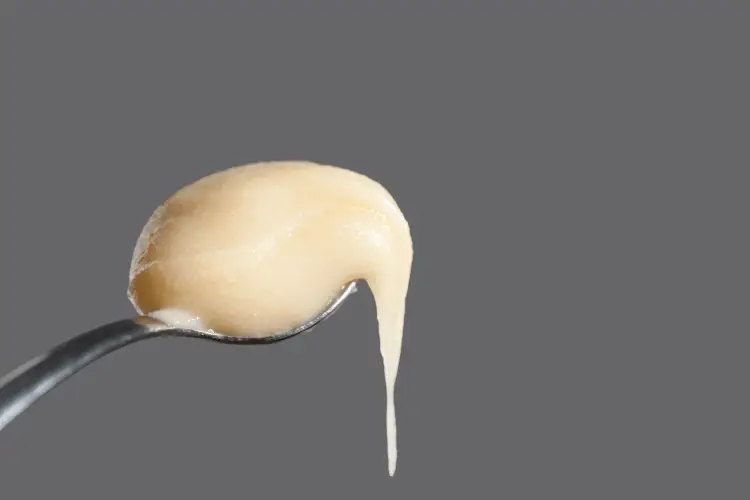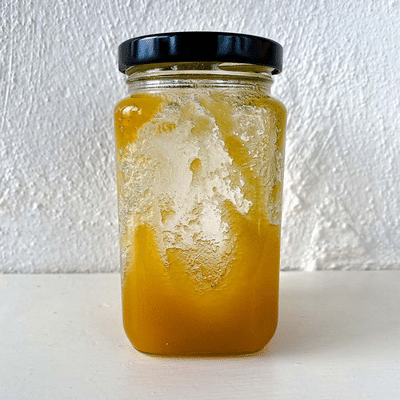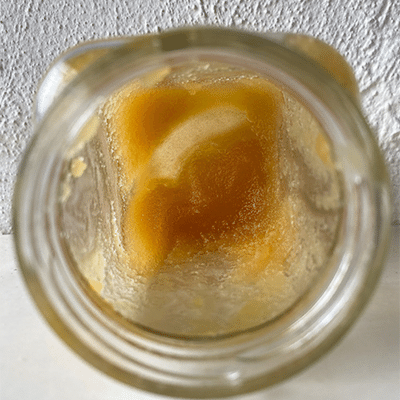If you regularly enjoy using honey to sweeten your drinks and meals, you’ve probably heard of creamed honey.
Have you wondered how different it is from regular honey?
Creamed and Regular honey come from the same main ingredient – raw honey. However, creamed honey undergoes a different crystallization process than regular raw honey. This process is what gives creamed honey its well-known smooth texture.
Creamed Honey
Creamed honey is essentially regular honey. However, after being filtered, it goes through an additional process before getting bottled – this is what gives creamed honey its unique, buttery texture but no other ingredients are added!
Creamed honey starts as raw honey – it’s collected from beehives, extracted, and strained like regular honey and then goes through controlled crystallization.
During this last step, the honey crystallizes like any batch of raw honey, but its granules are smaller than those in cloudy raw honey.

Commercial producers usually make creamed honey with a particular machine called honey creamer.
This piece of equipment evenly mixes the liquid honey with seed honey (already creamed honey) and stirs it frequently to break up large crystals.
Regular Honey
Regular honey is the honey you usually use and buy from farmers’ markets and larger retailers like supermarkets.
Honey can be raw or pasteurized.
Raw honey is harvested, strained, and bottled. In contrast, pasteurized honey is heated at controlled temperatures and cooled down again to effectively kill all the yeast spores that can cause fermentation.
Besides reducing the risk of fermentation, pasteurization also prevents crystallization. Therefore the honey will stay runny for longer.
Most kinds of honey sold at supermarkets are pasteurized (unless labeled as raw), so it can maintain its initial characteristics while on the shelf.
But to keep things simple, in this article, regular honey refers to raw (unpasteurized) honey.
Similarities Between Creamed Honey And Regular Honey
Both types of honey are unpasteurized. This means they aren’t processed with heat – they maintain the natural properties derived from the nectar they come from, such as aroma and flavor.
Because they are unpasteurized, they also have the natural tendency to granulate or crystallize over time.
Differences Between Creamed Honey And Regular Honey
Crystallization Process
Because both types are (or start as) raw honey, they naturally crystallize. However, the crystallization in creamed honey is induced and controlled, so it reaches a specific consistency.
In contrast, regular honey simply granulates over time. Depending on the nectar source, it will crystallize at a different rate and form larger or smaller crystals. For example, clover honey is known to be on the creamier side and crystallize faster.
However, in general terms, granulated regular honey won’t have the smoothness of creamed honey and will most likely go rock solid in the jar.


Physical Characteristics
Overall, creamed honey is lighter in color, has a creamier texture, and is easier to spread. That’s why most people prefer using this type of honey to spread on foods that tear and break easily, such as bread and thin crackers.
How Much Does Each Honey Cost
It depends on a few factors like the country, the variety (nectar source) of honey, and how available it is.
However, creamed honey can usually be more expensive as it takes longer and requires an extra step. Some producers even use specialized equipment to reach the desired consistency and texture.
In the United States, you can find a 16 oz (453.5g) between $7-$12, while a similar jar of raw honey can be around $5 (excluding the expensive varieties like Manuka honey).
Is Creamed Honey Better Than Regular Honey?
In general terms, creamed honey is not better than regular honey because its properties are the same. The only difference is the texture. Whether a creamy, runny, or solid texture is better, I believe that is a matter of personal preference.
I like the texture of creamed honey – it’s easy to scoop out of the jar and spread on my bread without tearing it apart and making a mess. But, for hot drinks like tea, I simply use solid or runny honey as it dissolves regardless of the texture.
So, it’s really up to you, your taste, and how you plan to use it.
Is Regular Cloudy Honey The Same As Creamed Honey?
Regular cloudy honey is not the same as creamed honey. Raw solidified honey has larger crystals that make it quite rock hard. Instead, creamed honey remains buttery and spreadable after it has been spun.
Depending on the type of honey, its texture can vary a little. However, unless spun (creamed), it won’t have the same consistency as creamed honey.
Conclusion
Regular and creamed honey are unpasteurized, meaning they haven’t been processed with heat. Because of this, they granulate or crystallize over time.
The main difference between creamed and regular honey is how they crystallize.
The crystallization in creamed honey is induced and controlled, which creates the buttery texture this honey is known for. In contrast, when regular honey granulates, it makes bigger crystals that turn it hard and less spreadable.
Creamed honey is lighter in color, has a creamier texture, and is easier to spread than regular honey. It also costs more than regular honey because it requires an extra step to make and sometimes special equipment.
